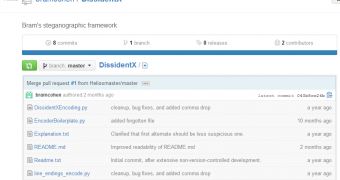Bram Cohen, the man who created the BitTorrent protocol, is working on a new project named DissidentX, something he calls a censorship resistance tool. The innovative steganography tool will allow users to hide their secret communications in websites, documents, and even media files.
According to Forbes, DissidentX is being created in a partnership with a group of researchers from Stanford.
Cohen says the aim of DissidentX is to facilitate the transmission of sensitive information without providing any indication that the communication is taking place.
Unlike current steganography techniques, which can be detected, the system proposed by Cohen is based on cryptographic hashes that represent an encrypted version of the message that is being sent. The recipient holds the key to decrypting it.
“There’s no particular place in the cover text where the bits of the encoded message are hidden. It’s distributed holistically across the entire thing,” Cohen told Forbes’ Andy Greenberg.
“It’s taking the entirety of the cover text and mashing it all together as a complete unit to create a hash carefully constructed so that it has the properties you want.”
What’s interesting about DissidentX is that is can be used to encode a number of messages in a single file. Each of these messages can be decoded with an associated decryption key.
The fact that a certain key can be utilized to obtain a certain piece of information is also useful in case the recipient of the secret communication is caught and forced to give up the decryption key. He/she can hand over one key that reveals a false piece of information.
Currently, for the method to be efficient, the cover file must be 500 times larger than the secret message. However, Cohen is working with Stanford cryptographers on implementing an algorithm called Lenstra – Lenstra – Lovasz to improve it.
In a real-life scenario, human rights groups could plant hidden messages on TOR websites. The communications can be read by political dissidents by using a browser add-on that checks every webpage for hidden texts.

 14 DAY TRIAL //
14 DAY TRIAL //